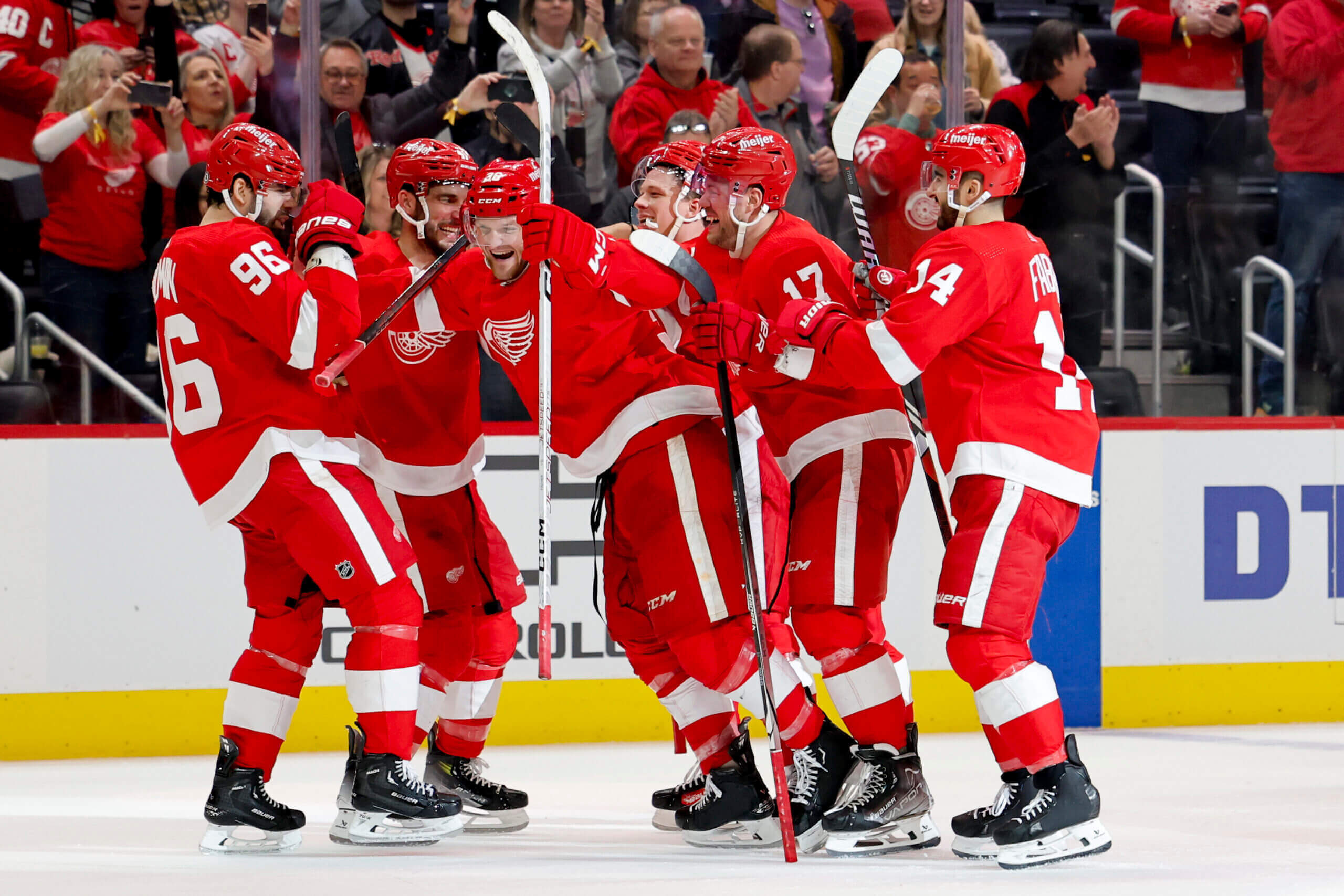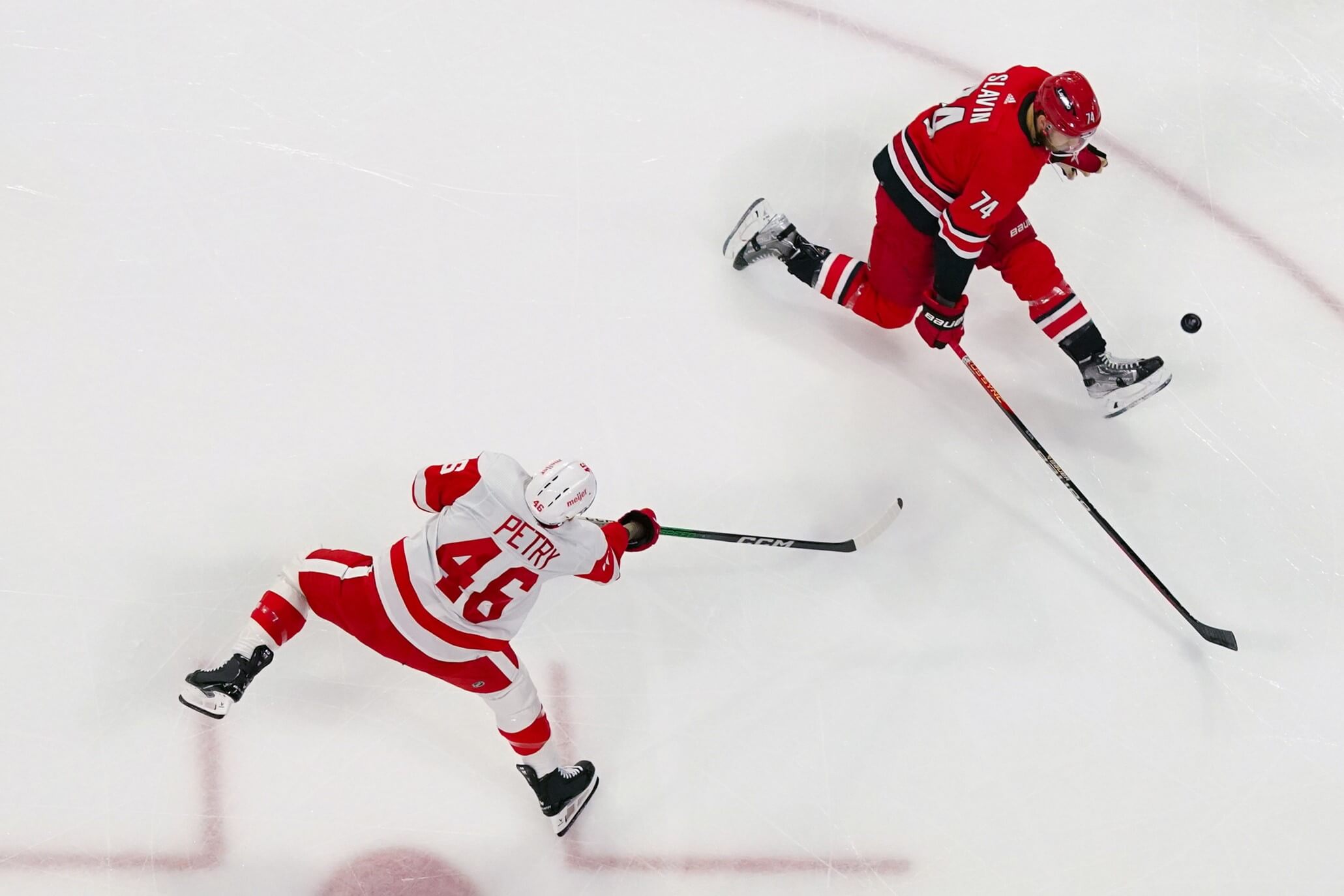DETROIT — First, it was pretty. Then, it was gritty. And in the end, it was “Griddy.”
That’s the anatomy of the Detroit Red Wings’ 4-3 overtime win over the Vancouver Canucks on Saturday in their first game back from the All-Star break — or, at least, most of it.
Before the Red Wings departed for a nine-day break to kick off February, their head coach, Derek Lalonde, warned of the dangers of losing the “muscle memory of how hard we’re actually competing.” And though Lucas Raymond’s goal-of-the-year candidate in the game’s first minute set a nice tone, there was indeed an ugly lull in the second period, including a run when the power play looked rusty.
But thanks to a fierce comeback in the third period, the Red Wings found a way to take 2 points from the league-leading Canucks and hit the ground running out of the break.
Here are six thoughts on how they did it and how it sets up a key month of February:
1. There’s been plenty of ink on Raymond’s breakthrough this season, but I still don’t know if the extent of his progress has been fully appreciated. His opening goal Saturday was a thing of beauty, showing great skill on a power move to the net and the patience to hold on to it for an easy finish less than a minute into the game.
LUCAS RAYMOND WHAT A GOAL! #LGRW pic.twitter.com/cyCaLaPAHJ
— Ryan Hana (@RyanHanaWWP) February 10, 2024
After that goal, Raymond sits at 14 goals and 42 points in 51 games, just 1 point (and four goals) behind Detroit’s marquee offseason acquisition, Alex DeBrincat. And considering DeBrincat has largely come as advertised (maybe you want a little more consistency in the goals department), that’s a huge development for the Red Wings.
Detroit had the idea all along of making a leap with its young internal forward talent, which includes Joe Veleno and Michael Rasmussen, but with Raymond as the headliner. The Red Wings wanted Raymond to establish himself as a top-line forward to reach their potential, and he’s done that. Not only with the flash but also, just as importantly, with an ability to win pucks for himself and his linemates.
Certainly, the story of this team still starts and ends with depth, but it’s hard to achieve that without pieces that fit at the top of the lineup. Raymond has been that, and it’s one of the more underrated reasons this team has gotten into a legit playoff race.
2. Raymond’s goal at the start gave the Red Wings an early boost, and as it turned out, they needed it.
Lalonde mentioned that, when observing the trends of games in which one team is coming off a layoff and the other is more in rhythm, the second period tends to be when it catches up. And that was the case Saturday, with Vancouver outscoring Detroit 3-0 in that period.
More concerning, though, was how it happened. The Red Wings got a five-minute power play after Nikita Zadorov was ejected with a match penalty for a hit to Raymond’s head, and they hardly accomplished anything with it. Then they got another two-minute penalty tacked on at the end when Filip Hronek hit Dylan Larkin in the face with a high stick, and they weren’t able to score on that, either.
Good things seldom happen after going seven straight minutes on the power play without a goal, and sure enough, Hronek got a breakaway immediately as he stepped out of the box and made the Red Wings pay. And when Elias Pettersson added another two minutes later, it looked like the Red Wings might have wasted the best opportunity they were going to get.
Lalonde said he was OK with the looks the Red Wings got in that span but was bothered by giving up the goal at the end of the sequence.
“The fact that we tried to squeeze it in at the end, and two D hang in there, it’s minor hockey,” Lalonde said. “Goalie’s slapping his stick — you read it, you get off the line. You don’t give them a freebie. We’ve done it (in) back-to-back games. So, we’ll take the power play. We won the power play battle 1-0. Against a team like that, we’ll take it. But just, again, really disappointed in that second goal.”
Detroit had already gotten a chance to get a second defender on the ice, to theoretically avoid precisely that, and so to have both defenders — in this case Moritz Seider and Ben Chiarot — out of range to get back into the play was something Lalonde called “unacceptable”
“That’s a detail you can’t have happen,” he said. “They’re too good to give them a freebie. Luckily, the group bailed us out on that one.”
3. To Lalonde’s point on the power play, the Red Wings eventually scored with the man advantage in the third period, with Daniel Sprong finishing a feed from Patrick Kane. That technically made them 1-for-4 on the power play, which at 25 percent is a conversion rate they will take in any game. And when you add in Jake Walman scoring on a penalty shot in overtime, they made the Canucks pay for their mistakes enough to win.
The power play still needed to do more with an extended opportunity like the Zadorov penalty, though. Maybe it was rust, and there was a great look from Kane to Sprong that was intercepted, but it wasn’t the sustained heavy pressure you expect when a team is on its heels like that. Especially with Vancouver missing a defenseman.
It’s not a cause for alarm after just one game back, especially in a win, but it’s fair to monitor the power play these next couple of games to see whether the units can find a little more cohesion.
Jake Walman (@walman_9) nets the @Energizer overtime winner on the penalty shot!
Guess what his celly was… pic.twitter.com/EHX5Lgd0bU
— NHL (@NHL) February 10, 2024
4. Walman’s breaking out the “Griddy” celebration after his game winner was more meaningful than just the celebration, for a couple of reasons.
First, he hadn’t done it at home, and on Kids Day at Little Caesars Arena, the celebration’s core demographic was certainly in attendance.
And second, Walman announced he’s planning to roll out T-shirts with a silhouette of him doing the move. He said he plans to sell the shirts at a pop-up shop at the arena this season, with proceeds going to Detroit’s Boys & Girls Clubs. He said he visited the club last year and wants to improve its gaming section.
It’s a nice touch to capitalize on the move.
Alex DeBrincat dropped the gloves with Vancouver’s Ian Cole on Saturday. (Rick Osentoski / USA Today)
5. DeBrincat fought for the second time this season Saturday, dropping the gloves with Vancouver’s Ian Cole when Detroit needed a spark late in the second period.
It certainly accomplished that, taking on a player well outside his weight class, but Lalonde took the opportunity to tell a funny story about the last time DeBrincat fought this season: against Roman Josi in late December.
“It’s funny — if you put the math together, our little run into January started with him fighting Josi,” Lalonde said. “And my son texted me after the game. They were out on the East Coast playing, and he’s like, ‘That’s going to be the turning point of your season.’ And kind of like when (David Perron) said we were going to get (18) points, I was like, ‘Eh, (have you) not watched us lately?’
“But I just think when someone like that does that, just shows some character, you fight out of your weight class like that and handle yourself well like that, I think it just lifts the group. So that was a nice spark, for sure.”
6. It was fitting that Detroit’s tying goal came on a clinical forecheck sequence from Christian Fischer and Rasmussen, who worked the puck to Walman at the point, and then Rasmussen tipped in his shot to make it a tie game.
“Love that goal,” Lalonde said.
That line of Fischer, Rasmussen and Andrew Copp was one of the Red Wings’ key discoveries in January, and it was a big deal to see them hit the ground running.
“They’re clearly workhorses,” Walman said. “All those guys love to compete and battle, and you saw it today. They get to the net, and I think that’s how we’re going to generate a lot of our goals as a team, just being scrappy. And it’s fun to see when they’ve got that aggression. It really sets the tone for the group, for sure.”
I thought of the contrast between that goal and Raymond’s dazzling one when Perron spoke about what the team was capable of, starting his answer with “a lot.”
“We win in different ways. That’s what’s so special about us,” he said. “I think as our details keep getting better and better every single game, as we understand how important every puck is in the D-zone, all that stuff, playing the right way, I think we’re going to get better and better. And that’s what is really exciting about our team.”
Certainly, the Red Wings reined in their game from a run-and-gun style to a much more structured approach in January, leading their defense to improve markedly. That gives them a better foundation while still knowing they can make a late push when they need one.
Lalonde credited the group for Saturday’s comeback while cautioning it was “not a recipe for success. You don’t want to continue to put yourself in those situations, especially against elite teams like this.” And, of course, that’s true.
But being able to stick to their game in those comebacks, as the Rasmussen goal showed, is what’s most encouraging about the performance. It wasn’t simply throwing caution to the wind and chasing.
Now more than 50 games into the season, the Red Wings (who occupy a wild-card spot) have a path to the playoffs. It’s going to be a battle to get there, though, and this upcoming trip through the Pacific Northwest (including at the Edmonton Oilers and Canucks next week) is critical in setting that tone.
And after knocking off Vancouver on Saturday, it’s fair to say their playoff chase has begun in earnest.
(Top photo of Jake Walman being congratulated by his teammates after scoring a penalty goal: Rick Osentoski / USA Today)



